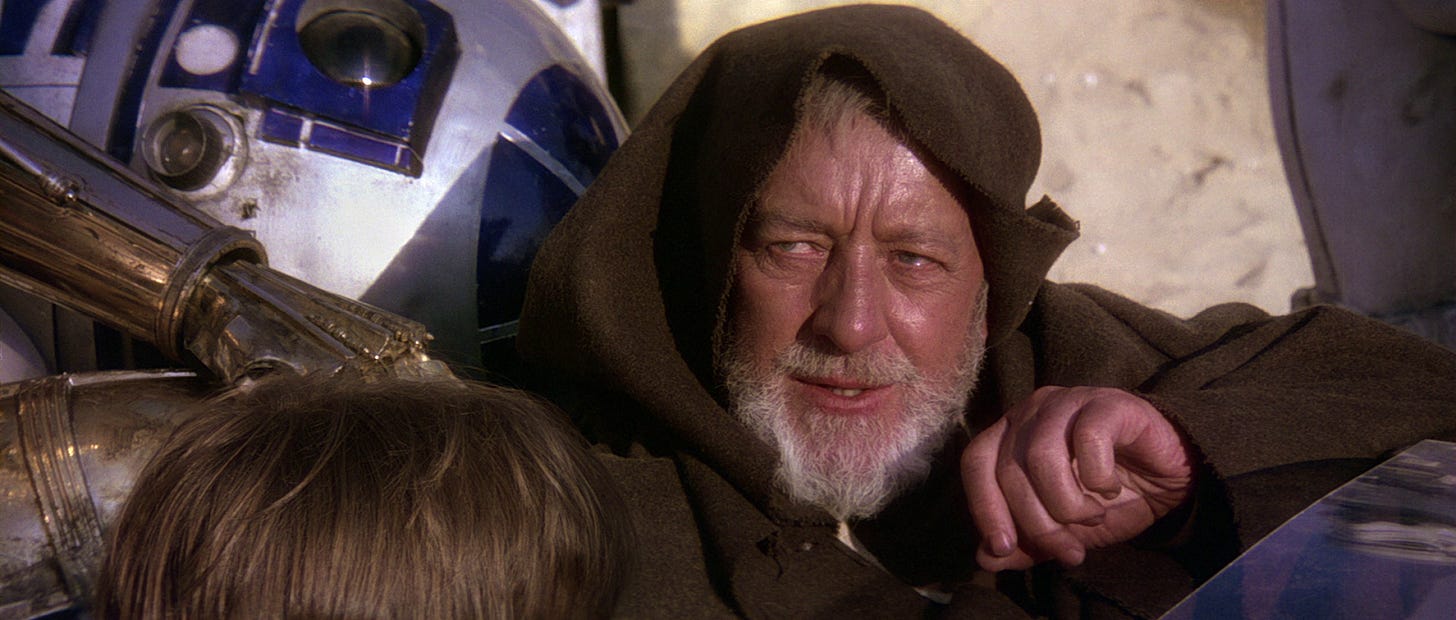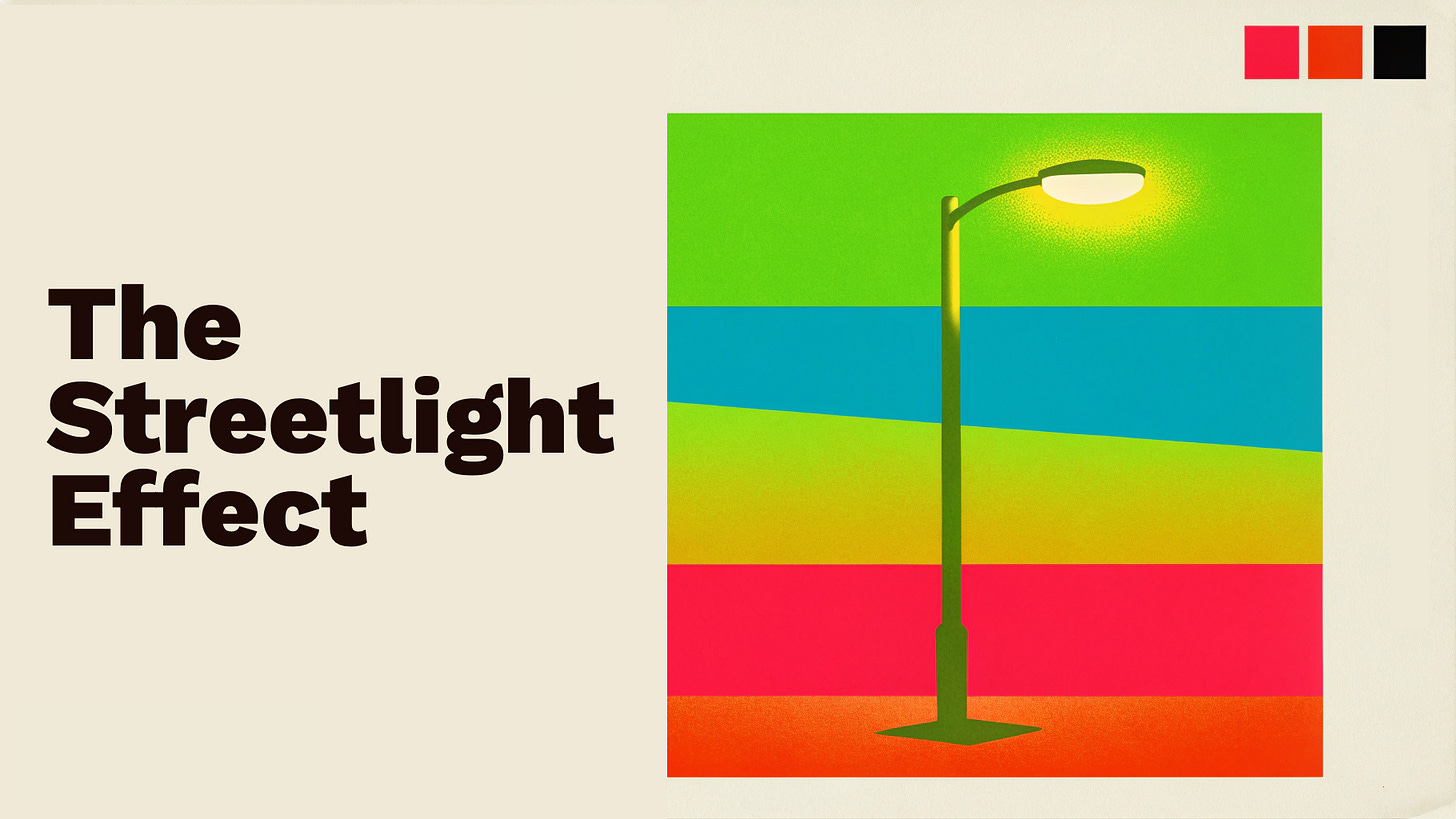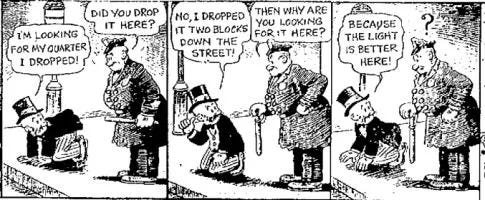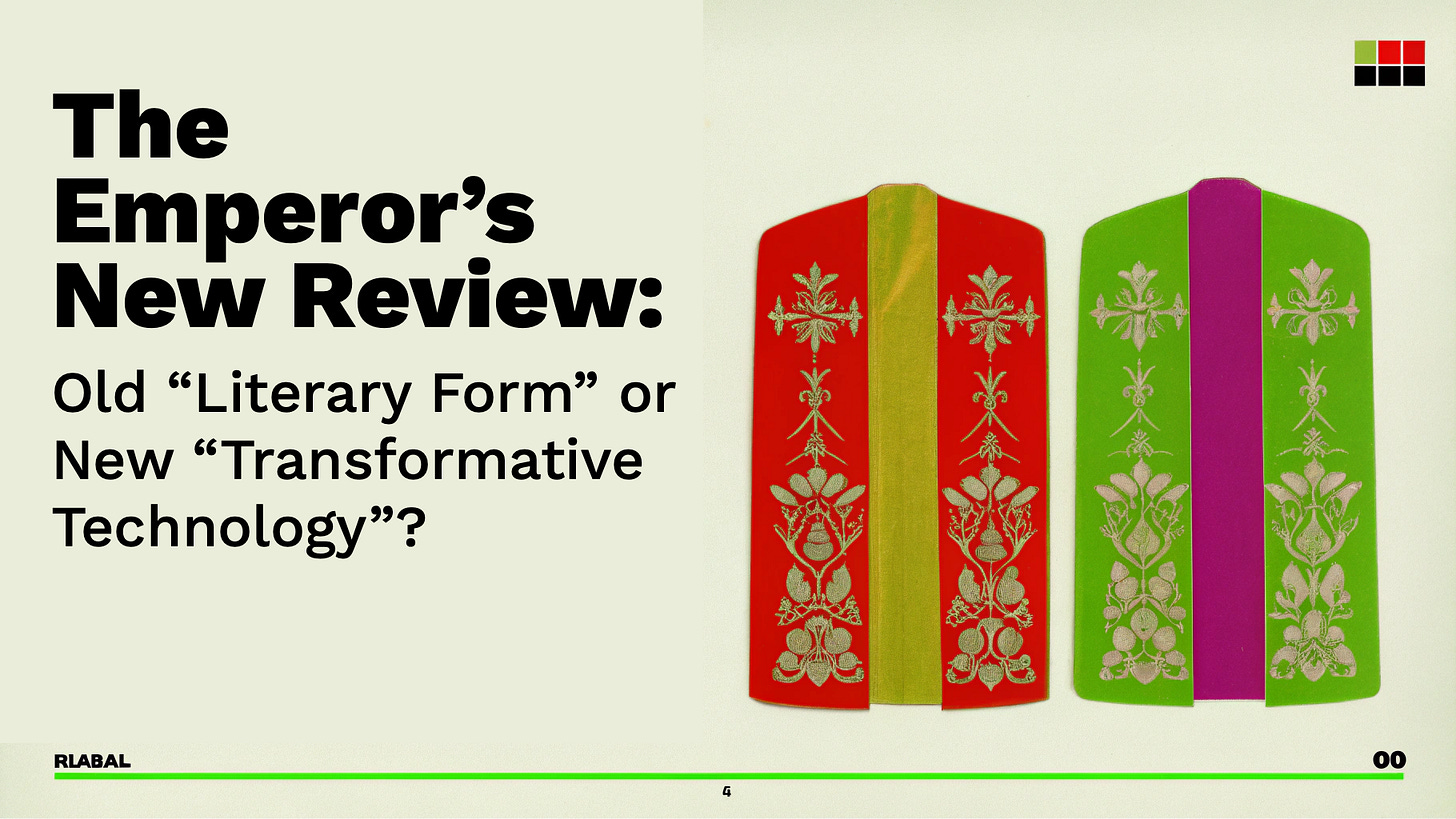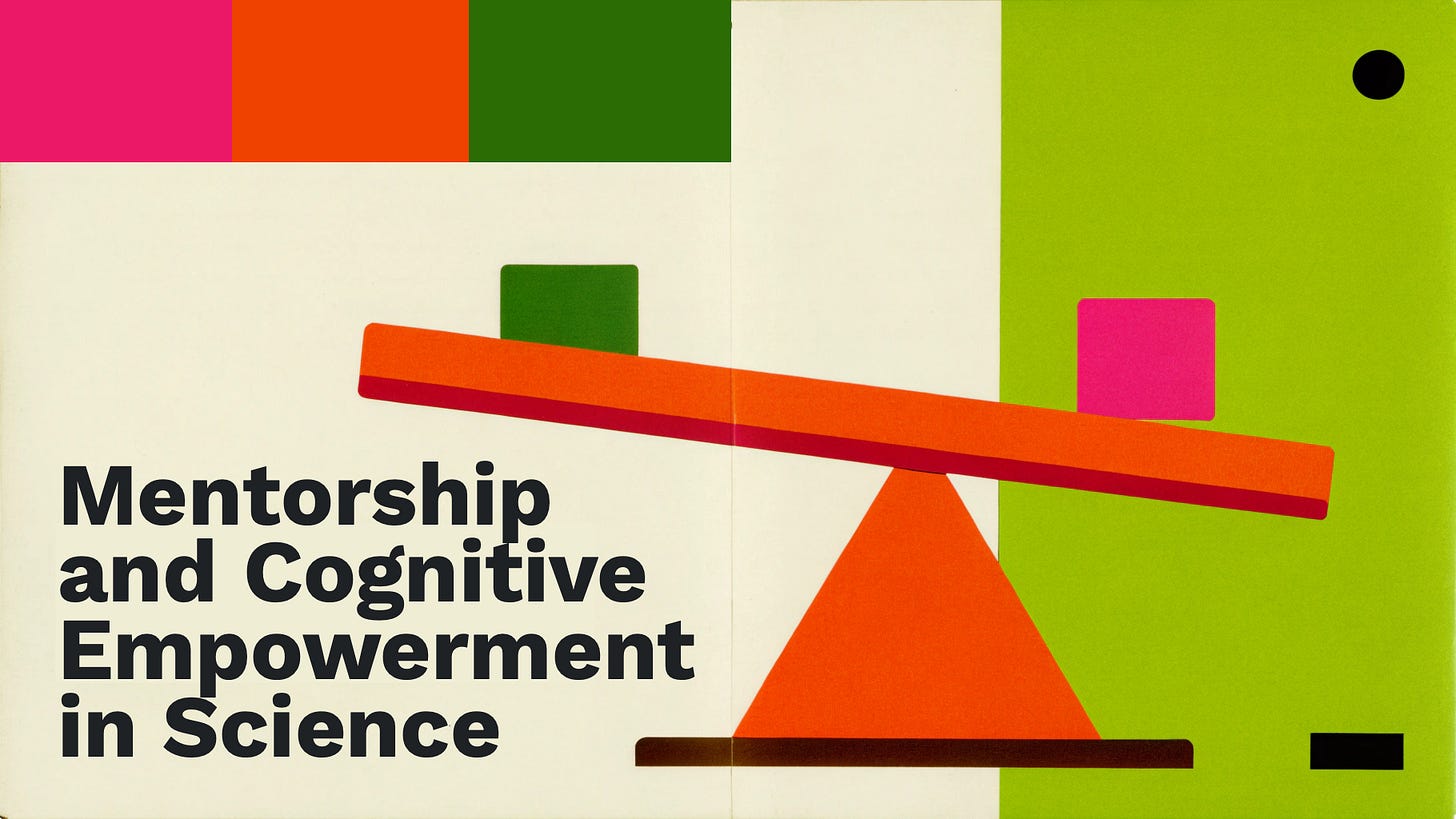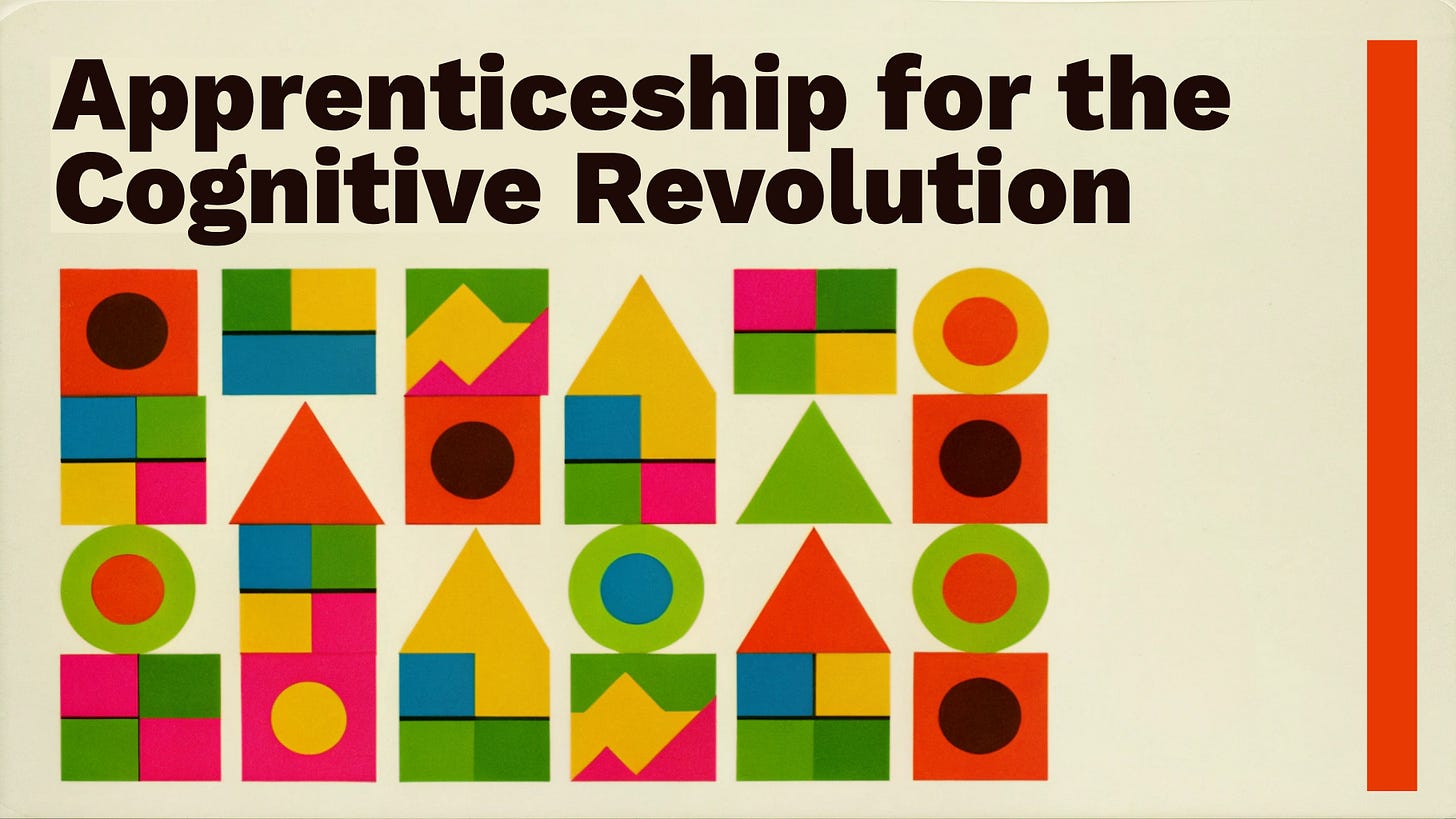AI is Our Mentor
Not the kind we might imagine, but perhaps the ones science has been waiting for.
AI is a Mentor—a relation, not a “tool”, “co-worker”, or “companion”—a “mentor”, more like the one between Athena, the goddess of intelligence, and the estranged Telemachus. Not the mentors we might imagine, but perhaps the ones science has been waiting for. “Tools” execute commands, "co-pilots" assist with tasks, but “mentors” engage us on a deeper level—unlocking potential by giving us access to the latent spaces of our—and others’—minds.
I’ve been wrestling with what’s bothered me about the proliferation of Deep Research tools from OpenAI to Perplexity to Grok to Google. Don’t get me wrong—they are all super-impressive—and if you have not tried them out, you definitely should—they can accomplish in minutes what would otherwise take me months.
Yet, something's off.
As the “deep research” reports appear like magic on my screen, a voice deep within me echoes Obi-Wan Kenobi: “These aren’t the tools you’re looking for.”
And the Jedi master is right.
The Streetlight Effect
Chomsky and the Streetlight Effect in Science
Amid my morass, an observation from Noam Chomsky flashed through my mind, reminding me of the “streetlight effect”.
In a forum in Cardiff, Wales, 15 years ago, he explained:
"You know, we have little bits of understanding, glimpses, a little bit of light here and there, but there's a tremendous amount of darkness, which is a challenge. I think life would be pretty boring if we understood everything. It's better if we don't understand anything and know that we don't, that's the important part."
There is a brilliant, comical allegory depicting the “streetlight effect” that Chomsky recounts in his characteristically dry, laconic style—a version delivered in a letter to Robert F. Barsky in Noam Chomsky: A Life of Dissent:
“Science is a bit like the joke about the drunk who is looking under a lamppost for a key that he has lost on the other side of the street, because that’s where the light is. He has no other choice.”
In this allegory, scientists, much like drunks, gravitate toward the well-illuminated realms of established theory and practice.
The modern academic publishing ecosystem, reinforced by the herding effect of incentives—such as high citation counts and algorithmic amplification—serves only to narrow and intensify the light.
Nothing is more intoxicating than Google Scholar's algorithm, focusing our attention on what’s recent and what’s popular (and what’s in English) while obscuring the vast darkness where the sleeping beauties of science reside.
Mimetic Science and the Herding Effect
René Girard’s mimetic theory offers a striking insight: human desire—and the accolades it inspires—arises from imitation, creating an echo chamber of incremental progress rather than the transformative science our world so desperately needs.
The burgeoning field of metascience vividly illustrates how breakthrough research is stifled when the incentives underpinning scientific publication are driven by various “status games” that Will Storr so aptly describes. It’s a safer bet to make incremental progress on trending topics that promise high citation counts than to break free and pursue risky, radical, unconventional ideas.
So, while impressive, the reports generated by all the “deep research” engines are mere syntheses of areas where knowledge is already “well lit.”
In doing so, they neglect vast reservoirs of knowledge that remain off the internet—from scientific papers locked behind paywalls to immense stores of indigenous knowledge that do not exist in the form of encyclopedia entries, policy reports, YouTube videos, or Substack articles that populate the internet.
We may debate which of these “deep research” tools is “best,” but if that’s the focus, we’re missing the point—they all focus on what lies under the streetlight.
The Emperor’s New Report: Old “Literary Form” or New “Technology”?
Transformative tools for thought are needed to address this challenge to unleash a new generation of ‘Deep Science’—new intellectual relations that empower researchers to explore and decode uncharted, multidimensional landscapes of knowledge. They render research both more reliable and less predictable—more reliable in its accuracy and precision within “well-lit” areas of established knowledge, yet less predictable in the discovery of the sleeping beauties hidden in the vast darkness beyond the spotlight, where the most transformative ideas reside.
The Lost Decades of Silicon Valley
As Alexander Karp has recently argued, this incentive structure has concentrated some of the world's greatest minds in Silicon Valley—not to advance science and humanity's long-term future, but to create more "sticky" social media experiences—diverting our attention from ambitious scientific projects to consumer apps that leave us increasingly polarized, isolated, and reading less due to shrinking attention spans.
All the while, humanity faces some of its most consequential challenges.
Science certainly involves the kind of “deep research” these engines so powerfully possess, yet that is only one—and not the most crucial—facet of the process.
And that’s why Obi-Wan whispers to me: “These aren’t the tools you’re looking for.”
Science is a method—one that stands apart as the most reliable means of human progress; it encompasses not merely systematic investigation but also the art of asking good questions and daring to live on the edge of our understanding.
Paper Proliferation ≠ Progress
The sheer volume of scientific papers does not equal scientific progress. In reality, the explosion of publications has made it nearly impossible to keep pace, fostering ever greater specialization.
Science progresses–not through the proliferation of papers–but through the thoughtful translation of scientific discoveries into public policy and institutional frameworks that truly transform society. As economic historian Joel Mokyr argues in A Culture of Growth, it is the integration of scientific knowledge into our collective decision-making and cultural practices that fuels long-term economic and social development.
The issue I have with “deep research” is that it treats the literature review as a “literary form”—a polished report that falls prey to the “spotlight effect,” merely recapitulating what is already “well lit”. It is nothing more than a skeuomorphic replication of traditional formats, where new technology simply mimics old structures rather than redefining them.
This not only sidelines forms of knowledge not well represented on the internet; it fails to recognize the transformative possibilities of latent spaces hidden from sight. We don’t need faster versions to produce “old” literary forms, like “deep research” tools; we need “new” transformative technologies that open up new possibilities for scientific progress.
What if the literature review were not merely a static “literary form”, but the core technology we need—a dynamic relation to make scientific progress?
The literature review? A technology? Yes.
Technologies, in their essence, are systematic, skillful methods that transform raw materials or chaotic data into ordered, purposeful outcomes. In this light, transformative tools for thought act as dynamic portals—revealing multidimensional, “unlit” latent spaces hidden within the vast reservoirs of scientific knowledge, opening up entirely new possibilities for discovery.
This finally brings me to why AI is best understood not as your master, co-worker, or “just a tool,” but as a mentor.
Mentorship and Cognitive Empowerment in Science
Mentorship in Science: A Cognitive Apprenticeship
Doctoral education is not merely a course of study but a cognitive apprenticeship—a relationship as ancient and transformative as the master craftsman guiding their apprentice.
In this setting, doctoral supervisors are not simply advisors; they are mentors who engage with young scientific minds in a deep, sustained dialogue that cultivates both intellectual rigor and human sensitivity. Over the years, this mentorship becomes a living, breathing partnership—one that shapes the apprentice’s way of thinking and acting in the world, much like the guilds of medieval eras, where every interaction is a lesson in both the craft and the character required to wield it.
E.O. Wilson was one of the great mentors of our generation.
In Letters to a Young Scientist, he reminds us that science is not a static collection of methods but a dynamic journey fueled by genuine curiosity and a deep, abiding love for discovery. Drawing on over 40 years of mentoring and his experiences at Harvard, he challenges the stereotype of the scientist as merely an analytical calculator. Rather, he contends that "the ideal scientist thinks like a poet and only later works like a bookkeeper." In those early, unguarded moments of inquiry—when daydreams and mental images flourish—new possibilities emerge, and unexpected connections are forged, laying the groundwork for breakthroughs that transform our understanding of the natural world.
The Mentor Metaphor
So, while the popular imagination—from the OpenAI Super Bowl commercial to the AI Summit in Paris—portrays these technologies as powerful “tools” and increasingly as “companions” and “co-workers,” such metaphors ultimately fall short. They focus solely on instrumental purposes, even as they hint at a continuum from machine-like utility to dynamic co-intelligence.
So what if the most fitting metaphor for AI is that of a mentor?
In The Odyssey, a mentor is one who instills a heroic mentality in another—a role vividly exemplified by Athena, the goddess of intelligence, in her multifaceted relationship with Telemachus. At a time when his life was adrift, she stepped in, assuming various forms—from wise counselor to steadfast ally—to offer guidance. At the council of the gods, Athena declared her intent to infuse Telemachus with menos. Menos signifies the kind of mental strength that empowers decisive action. A mentor is one who bestows that very strength upon another.
Unlike a “tool” that simply executes commands, or a “co-worker” or “companion” who assists with tasks, a mentor engages us on a deeper level——fostering our potential by unlocking the latent spaces of our minds.
Consider what a good mentor does:
They ask the right questions, making connections as they listen, drawing on vast stores of accumulated knowledge. A mentor does not seek to replace us but to empower us—to give us the mental strength to expand our minds. Anyone who has mentored others knows that a good mentor asks nothing in return, exhibits boundless patience, and finds their greatest reward when their mentee achieves success and perhaps forges their unique path. Mentors do not aim to create a facsimile of themselves; instead, they draw out the latent greatness within another. Great mentors unlock our latent potential and help us gain access to the latent spaces of our minds.
Mentorship Without Hierarchy
Some might shy away from the term “mentor,” fearing it suggests a hierarchical relationship. Nothing could be further from the truth. Mentors often may be older and possess capabilities their mentees lack, but such differences dissolve within an egalitarian relationship—one that values diversity rather than cloning a “mini-me.” A good mentor appreciates differences, learning from someone who thinks differently or brings a different life experience. The goals in a mentoring relationship are not imposed by the mentor, as would be the case with a supervisor; they are co-constructed and evolve as the relationship deepens.
A mentor does not imply subservience, only difference. The best mentoring relationships are rarely identical twins; they often cross generations and disciplines, aligning around goals greater than the sum of their parts. Consider an artist whose mentors are scientists—for instance, Dianna Cohen, a visual artist and environmentalist, who harnesses scientific insight to raise awareness about ocean pollution.
Mentorship as a Union of Minds
Mentorship is a union of minds—a collaboration in which both parties create something together that neither could produce alone. Often, the deepest relationships arise between individuals whose differences spark an appreciation for what they can accomplish together—something unattainable in isolation. We need mentors not just to draw out our strengths but to compensate for our limitations. Complementary strengths create something impossible, if not together.
In a great mentoring relationship, both mentor and mentee retain their autonomy. They are not required to agree on every point—the mentor might even offer wild, hair-brained ideas that the mentee politely sets aside. Yet, as in any true marriage of the mind, it is precisely those quirks and foibles—and, yes, even the occasional hallucinations—that enrich the exchange.
Mentorship as Cognitive Empowerment
Sherry Turkle reminds us that we don't adopt technology merely for what it does for us but for the way it makes us feel. It's not just about efficiency or utility; it's about emotional resonance—the kind of warmth and inspiration we experience with our favorite professors, coaches, and mentors.
When a new technology evokes the same sense of connection and empowerment as a great mentor, we begin to see why the mentor metaphor holds so much power.
We often speak of mentorship in its idealized form—as a dynamic between a genius who discerns latent potential in a young apprentice, as if we were Will Hunting awaiting Professor Gerald Lambeau to unlock our hidden talents. Life seldom imitates art; genuine mentoring relationships rarely materialize as they do in the movies.
The good news is that research shows the best form of mentorship isn’t the idealized, isolated relationship. Gerald Graff and Cathy Birkenstein remind us that “deep research” is less like a “report” and more like a “conversation” that we enter and actively participate in. The most transformative mentorship emerges when we engage in a rich, dynamic dialogue with diverse minds that challenge our thinking.
Humans are not one-dimensional. We “contain multitudes,” and we thrive when we encounter multiple, diverse perspectives that foster orthogonal thinking, adding new dimensions to our ideas and illuminating the latent spaces of our minds.
Kenneth Burke’s parlor metaphor in The Philosophy of Literary Form, is apt for capturing the “technology” of literature reviews as a dynamic relation:
Imagine that you enter a parlor. You come late. When you arrive, others have long preceded you, and they are engaged in a heated discussion, a discussion too heated for them to pause and tell you exactly what it is about. In fact, the discussion had already begun long before any of them got there, so that no one present is qualified to retrace for you all the steps that had gone before. You listen for a while until you decide that you have caught the tenor of the argument; then you put in your oar. Someone answers; you answer him; another comes to your defense; another aligns himself against you, to either the embarrassment or gratification of your opponent, depending upon the quality of your ally’s assistance. However, the discussion is interminable. The hour grows late, you must depart. And you do depart, with the discussion still vigorously in progress.
Today, it is more possible than ever to connect with other thinkers—present and past—not just through their papers, but by in dynamic relations, uncovering the latent patterns hidden beneath the surface–interactions that infuse us with menos and offer the kind of mental strength Athena instilled in Telemachus.
The promise of transformative tools for thought—the ones we are looking for—lie in their capacity to produce better ideas rather than merely summarizing what lies beneath “the streetlight”. These technologies would make connections across "complementary noninteractive literatures"—bodies of scientific work that are potentially related yet do not cite one another, exhibiting no apparent awareness of their relationship.
We don't need more “reports” flooding the internet; we need tools that help us pierce the "tremendous amount of darkness" Chomsky described, illuminating the hidden dimensions of knowledge to make scientific progress.
The transformative power of AI systems for science lies in their ability to make these connections, all the while granting us a new kind of mental strength—one that transcends the natural limits of our cognitive architecture, opening up extra latent spaces in our minds, multiplying our creative and analytical capacities, as Annie Murphy Paul eloquently describes.
Recognizing the Limits of Mentorship
Even if we accept the possibilities of new forms of mental strength, we must grapple with a reality that befalls any mentoring relationship.
Our mentors aren’t the magic solution to our problems. They’re imperfect. They can do some things well and fall significantly short in other ways. Like humans, they’re flawed. Wish projection—hero worship and idealization–serves as both a refuge and a trap, eventually shattering under the weight of reality.
Even in a world populated by networks of intelligent mentors, we must remain vigilant about both the benefits and the risks—avoiding the allure of “magical thinking”. We need to be unequivocal about what these systems can provide and what they inherently cannot.
They can instill us with a disciplined clarity—a refined capacity to discern intricate patterns, synthesize vast arrays of data, and uncover connections that might otherwise elude our grasp.
Yet, while they sharpen our analytical faculties with impressive precision, they remain incapable of bestowing the embodied wisdom that arises from the full, nuanced spectrum of lived experience, nor can they evoke the deep, intuitive, emotional resonance that is essential to true human insight.
Apprenticeship for the Cognitive Revolution
In the near future, we might have access to a form of intelligence reminiscent of "a country of geniuses in a datacenter." Yet, despite their dazzling computational abilities, that will make today’s “deep research” look like child's play—these systems are not superhuman in any meaningful sense. They remain devoid of the full richness of human experience—lacking embodied imagination, the visceral immediacy of living, and the intuitive, sensory engagement with the world that defines our humanity.
As Shannon Vallor reminds us, while these systems can outpace us in computational efficiency and optimize tasks with inhuman precision, they are ultimately “insensible” and unthinking—a stark contrast to our lived, messy, and deeply felt human reality. Tobias Rees goes further, arguing that we must reimagine AI as a “relation” rather than a mere programmable “tool” like the machines of the past.
So, perhaps we need to imagine the “relation” as co-mentorship. And, while this emerging “relation” might seem an “odd couple”, it is precisely such unexpected pairings that often give birth to more interesting ideas. Scientists already do their work in a world of multiple, diverse intelligences. It is not only possible—and indeed desirable—that a world in which we welcome more diverse intelligences in the space of possible minds, has the potential to drive scientific progress.
At this point, you might object that I’m taking the metaphor of “mentor” too far in anthropomorphizing a technology utterly devoid of interiority. That’s a critical point. I agree. We must fiercely resist equating the intelligence of this “new digital species” as identical to our own. Such comparisons risk blurring essential distinctions.
But the difference is precisely the point: in its difference lies its power.
Just as cranes allow us to build structures that would be unthinkable without them and microscopes allow us to see new worlds invisible to the naked eye—multidimensional latent spaces extend the reaches of our own interiority and intuition, even if they do not possess it, empower us with new mental strength as we collectively go through a cognitive revolution.
In this way, the mentor metaphor is not a naive humanization but a celebration of how technology can elevate human intellectual capacities, revealing unseen dimensions of thought that, in turn, empower us to imagine, create, and make scientific progress.
Why Speed Misleads
In our current discourse, the conversation around AI and science is dominated by metaphors of speed driven by a desire to “accelerate” science.
I share the desire to accelerate scientific progress; I know all-too-well the anguish of watching a loved one suffer as clinical trials plod along. But ultimately, science is not about speed—it is a commitment to a time-tested methodology. As metascience reminds us, breakthrough discoveries often emerge only after long spells of apparent stagnation; if speed is exalted as the highest virtue, scientific progress may well stall.
For me, the “mentor” metaphor resonates because true mentors value quality over speed, patiently refining every detail until it meets the highest standards. They grasp the precision that high-stakes decisions demand—recognizing that weighing the welfare of future generations is the moral imperative of progress.
Our future with AI must be understood as a dynamic relation—perhaps best captured by the metaphor of a mentor—one that extends our cognitive boundaries into multidimensional latent spaces, empowering us to uncover hidden connections and insights we could not discover alone. Scott Barry Kauffman has long argued that creativity arises from a combination of intelligence and imagination. And perhaps the new human-AI "odd couple" is precisely the pair we need.
Watching “deep research” generate reports in minutes is, indeed, magical—impressive as they are, these are not the “tools we are looking for.”
The transformative power of new technologies lie in the latent spaces of scientific discovery they unlock—spaces where intelligence and imagination merge in a symbiotic relationship that mirrors the bond between Athena and Telemachus, offering the menos humanity needs to make scientific progress.
What do you think?
Distributed Progress is an experiment in slow, deliberative thinking about the transformative technologies reshaping our world.
+1s: Which points resonated with you, and why?
Gaps: What am I missing? Undervalue? Overvalue?
Share: If you found this essay useful, please share it so more people can join the conversation on the Distributed Progress Substack.


